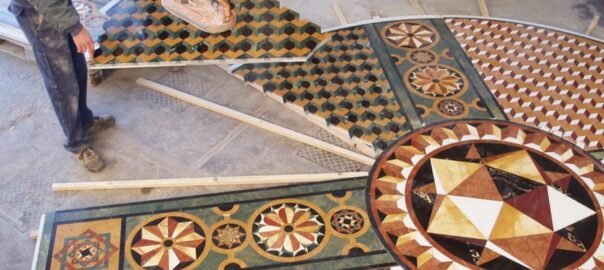
The sequence of processes that culminates in the realization of a masterpiece of marble inlay was perfected by the Mughal artisans in the 17th century, and has remained largely unchanged for over 400 years.
Although the art still makes use of tools & technique from the Mughal era, but the precision in workmanship that master artisans achieve with their superb skills, cannot be replicated by most modern day machines.
Marble Emporium has preserved this art in its most original form. In our workshops each masterpiece passes through various stages of creation, broadly divided into the planning and the execution phases.
- Each project is meticulously planned by the master artist, who begins with a crisp understanding of the project and creation of a concept according to customer’s specifications.
- He then lays foundation of the entire process by dividing the marble panel in symmetric sections using traditional geometric tools, and making a final sketch of the selected design on 1:1 scale.
- This entire drawing is traced on a brass sheet, which is cut out accurately by a specialist, to make templates of every component of the design.
- This leads to one of the most important phases of planning, which is the selection of gems and semiprecious stones for the motifs.
- Specially selected gem stones and precious materials such as Amethyst, Coral, Turquoise, Tiger’s Eye, Lapis lazuli, Malachite, Abalone Shell, Cornelian and Jade etc. are used to create an effect which is equivalent to “Painting with Hard Stones”.
- The execution of entire plan is now carried out by a team of highly skilled artisans, each responsible for accomplishing only one specialized phase of the complete process.
- This begins with the lapidary artists, who shape the selected gem stones on a hand driven tool known as “Saan & Kamaani”. These artists demonstrate exceptional precision in transforming these gem stones in delicate floral motifs.
- In doing so, tiny pieces of gemstones are held in the fingertips, and touched with an emery wheel, which is rotated by hand with great precision using a cane rod attached with a leather band. Such is the mechanism of these wheels that it gives absolute control in the hands of the artists whilst they shape the gem stones.
- This phase of recreating the entire design in stones can take from a few weeks to several years, depending on the intricacy and complexity of the motifs.
- Once accomplished, the work is transferred to the next set of artisans who specialize in setting of these gems in marble.
- This stage begins by arranging the shaped gem stones on the marble panel, at specific position marked by the master artisans. The contours of these stones are traced with a fine pointed chisel or a lead, to get an outline of each element on the marble. The stone motifs are then removed and kept aside in a chronological order.
- Using hand held chisels, the master setters engrave the marble with great care, to make grooves which correspond exactly with the gemstones. Such is the accuracy of the process that once inlaid there is no visible gap between the edge of the stone and the marble.This is not an easy process as the Indian marble is one of the hardest materials to work.
- Using specially prepared glue, the gem stones are inlaid in specific grooves created for every individual pattern.
- Finally the finished example is passed to polishing specialists, who use finely powdered “trade secret” mixtures of polishing compounds for this purpose. The traditional polish lasts 5 times longer than “modern wax” polish. However it is a procedure which is closely protected by only few expert exponents today.
- At last the whole project is carefully checked by the trained eyes and hands of the “Ustad” before delivery to the art gallery.



